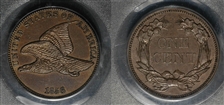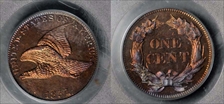G99G 的钱币相册
1857 1C PR63. Housed in a green-label PCGS holder is a splendid proof Flying Eagle cent. The design definition is bold, and the surfaces are excellent, with only a few minor abrasions in the mirrored fields. A few tiny planchet flakes, lint marks, and die lines are all as made on this brilliant cent.
1858 1C Small Letters PR65. When James Buchanan was elected to the presidency in 1856, that was not the only change afoot in the land. It was a transitional period for both the nation and its coinage, a four-year interim that hinted at what would follow. In 1856, the large cent was replaced by the new small cent. The small cents had a flying eagle motif on the obverse, a throwback to Christian Gobrecht's design from twenty years earlier, and the reverse had a wreath that would remain on all small cents until 1909. The flying eagle design, like James Buchanan, was transitional only. By 1859 it was gone, to be replaced by the Indian Head motif that would last well into the next century, just as Buchanan was gone and quickly forgotten in 1860 to be succeeded by the horrors of the Civil War and more than twenty years of Republican domination of the White House. The Flying Eagle Cent is one of the most enduring and popular of all coinage designs. In proof format, this design is at the pinnacle of aesthetic appeal. After they were introduced to the public the smaller sized copper-nickel cents were an immediate commercial success and business strike production quickly vaulted more than 24 million pieces in 1858. Very few proof cents, however, were ordered from the Mint that year and, although no exact mintage figures for proof Flying Eagle cents were kept, it is estimated that approximately 280 pieces of both the Large Letters and Small Letters varieties were struck. Of that meager quantity, the survival rate is very low, as many ultimately entered circulation. Perhaps 100 to 200 Small Letters proof cents were coined and distributed, including both High Leaves and Low Leaves varieties, apparently with 12-coin sets of copper-nickel cent patterns. Rick Snow estimates 75 to 100 pattern sets were made. Breen estimates the original population of this variety to be around 100 pieces, and claims to have seen 20 different specimens. This estimate is based on anecdotal information and guesses as to how many 1858 pattern sets were sold, how many proof sets were sold, and how many individual coins were sold. In other words, we don't know. Among proof Flying Eagle cents, this issue is the most often seen, however, still deserves the title "rare." Regardless of how many were actually made, this issue remains very rare today. It is generally believed that the dies, or at least the obverse die, were engraved by Anthony Paquet, using his letter font intended for dimes. Many of the letters have the slightly more delicate appearance usually associated with Paquet's work. This example is a light tan beauty with sharp design features, boldly struck on a thick, copper-nickel planchet.






















